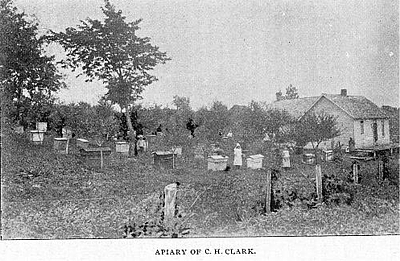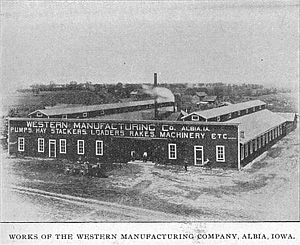Excerpts from An Illustrated History of Monroe County, Iowa - 1896
CHAPTER XVI ~ AGRICULTURE and MANUFACTURING.

C. H. Clark, a son of the late Wareham G. Clark, and who resides five or six miles southwest of Albia, has no doubt pursued the industry with the most conspicuous success of any bee-keepers in the county. He has at present from 40 to 60 colonies, but intends to increase the number to at least 100. He has his apiary on 88 acres of land, and estimates that on a area of 6 square miles 100 colonies of bees could be successfully maintained. He uses a nine-frame hive, and his experience has evolved some very important facts. He uses a square frame instead of one rectilinear in form. His reasons for adopting this form of frame are: the queen been invariably builds her cell in the center, and for some reason, but known to the bee itself, bees build their supply of honey above the queen's apartment, and leave the lower portion for brood-cells and bee-bread.
When Mr. Clark finds the upper half of the frame filled with honey, he removes the frame and turns it upside down, and by thus shifting the position of the frame until all four sides have been in their turn changed, the bees are forced to build in the boxes above, when they would otherwise have selected the frames.
From Mr. Clark's experience, he has determined that 100 colonies will produce 6,000 pounds of honey in a season. He sells his honey at from 10 cents to 20 cents per pound. If his product averaged 15 cents per pound at wholesale, 100 colonies would yield him a profit of $900 annually. Forty acres of land would be all the land necessary, and he could follow farming besides. He could sow say 10 acres of buckwheat to facilitate his bees in their honey-gathering, but they would not be altogether dependent on that, as the forest bloom, such as basswood, white clover, fruit blossoms, field clover, and the wilderness of asters, golden rod, and other yellow wild flowers that bloom in the early autumn along fence-rows, highways, and stubble-fields, usually make abundant food for bees. Of course there would be seasons through which he would have to feed his bees perhaps all winter.
Mr. Clark has two varieties of bees, the Italian and Carinolia. He thinks the Italian is the best, because it can reach the honey cavity in a large proportion of the red field clover bloom. The Carinolia is bee imported from Austria, and he considers this variety next best, having in his apiary about 20 colonies.
The first to engage in bee culture in this county was Peter Brown. Messrs. Oaks and Bachelor next started an apiary, but soon abandoned the enterprise.
Within recent years R. B. Arnold, of Urbana Township, has been pursuing the industry quite successfully in connection with horticulture and farming. He has 30 colonies, and intends to keep on increasing the number.
Henry Burner, Austin Jay, L. Snow, David Kenworthy, Alfred Weilman, and others are successful bee-raisers in Monroe County.
Mr. Clark, whose judgment in all practical matters can be fully relied on, states that from his personal experience, bee culture in Monroe County can be made a highly remunerative industry, and he earnestly recommends its investigation.
Manufacturing.

Monroe County contains one manufacturing concern of considerable — viz., the Western Manufacturing Company. This plant is located at Albia, and was established in January, 1895. It incorporated under the State laws, with an authorized capital stock of about $50,000. The amount paid in, however, falls below that sum. It organized with the following officers: Fred Townsend, president; W. S. Scott, vice-president; J. R. Clark, secretary and treasurer; W. S. Scott, H. I. Clark, O. F. Smith, Chas. Israel, and E. C. Hulbert.
The plant was located at Osceola, Iowa, prior to it organization in Monroe County, but as this county offered better transportation and fuel facilities, a local organization was formed of Monroe County gentlemen, the machinery was brought here and increased facilities added to the new organization. The company builds a very popular pattern of hay-ricker and rake; they also manufacture iron pumps of a high grade, and other mechanical sundries.
The company has not been in operation long enough here to solve the problem of whether a manufacturing plant will succeed in Albia or not. The greatest obstacle which inland manufacturing enterprises have to encounter is the large establishments of the manufacturing centers, whose unlimited capacity enables them to reduce all expenses to a minimum. Having this advantage, they are enabled to place their products before consumers at a price which will drive the smaller competitor into bankruptcy. The superior merits of the product of the Western Manufacturing Company, however, may achieve for the company a fair degree of prosperity. The concern usually employs from fifteen to twenty men. Its management is in the hands of staunch and reliable business men.
The Albia canning factory was organized in 1894 as a joint stock company, incorporated under the laws of the State. Its authorized capital stock was $21,000, of which amount $10,500 was paid up. The company was under the management of eleven directors: E. W. Byers, Ed. A. Canning, John R. Duncan, Max Loeb, J. S. Moon, A. A. Mason, John Forster, C. C. Acheson, C. W. Smallwood, J. C. Robeson, and Tom D. Lockman. E. W. Byers was president. Chas. W. Smallwood secretary, and J. S. Moon treasurer.
Owing to the crop failure of 1894, the management concluded to not operate the factory that summer. On accepting the plant from contractors, the directors started the machinery to see that everything was in good working order. Everything appeared satisfactory, and the company received the plant. On starting up in 1895, for the first time, it was found that the machinery, and especially the engine, was not set properly, and some expense was incurred in readjusting it. A well was also lacking, also piping and other fixtures, to supply all of which cost the company nearly a thousand dollars.
The machinery for working corn did not work satisfactorily the first season, and a large quantity of the canned product spoiled. Then the company paid the farmers more for the corn than they ought to have done in order to realize any profit on it. The result was that at the end of the first season's operations the company found itself $2,000 poorer than in the beginning. This, with the additional outlay incurred by supplying the well and meeting other deficiencies, discouraged the stockholders, and at a meeting it was ordered that the factory be sold to pay off the indebtedness. It was bought for $3,000 by Messrs. John Ralston, Max Loeb, J. S. Moon, G. H. Hobson, Tom D. Lockman, and R. O. Cramer, who are the present directors and proprietors.
The concern continues its charter as an incorporated body, and its capital stock is fixed at $3,000, all of which is fully paid up. It is establishing itself on a prosperous basis at present, and is under the management of R. O. Cramer.
Albia also contains a drain-tile factory, but it is not in operation at the present time. It is under the management of J. W. Harvey. It is not in a flourishing condition, owing to inability on the part of the proprietor to find a steady market for the product of the factory.
Transcriptions by Sharon R. Becker, September of 2010

